|
The growth of industry and commerce
in the Black Country was made possible by a great
improvement in the roads, and the building of canals and
railways. This allowed raw materials to easily be
brought into the region, or transported around it; and
finished products to be quickly delivered to many parts
of the country.
Roads
Walsall was at a disadvantage when
compared to neighbouring towns. The roads were in a
particularly bad condition, and were described as
narrow, tortuous, and ruinous. They were ill-kept and so
narrow that in most places there was not enough room for
two vehicles to pass each other. The situation was made
worse by the hilly nature of the town.
Much of the traffic passed along
High Street, either ascending or descending the steep
hill, which in winter months became impassable due to a
large sheet of ice produced from the water that came
from the pump at the top of the street. The sharp turn
into Rushall Street at the top of the hill was also
difficult because it was only about ten feet wide. |
| In the 17th, 18th, and 19th centuries, roads were
improved and maintained by turnpike trusts, which were
bodies set up by individual Acts of Parliament. The trusts
had powers to collect tolls to maintain roads, and often
erected toll houses for the purpose.
A trust was established for 21 years, after which the
responsibility for the road would be handed back to the
local parish. Often trusts would apply for an extension, and
exist for a longer period.
They were known as turnpike trusts because of the
similarity of the gate which controlled access to the road,
to the turnpike barrier used to defend soldiers from attack
by cavalry. |

The toll house and toll gate, Penn
Road, Wolverhampton.
|
| By the 1830s there were more than 1,000 trusts,
maintaining around 30,000 miles of road in England and
Wales. From 1766 trusts were required to build milestones to
indicate the distance between principal towns on the road.
Road users were obliged to follow new rules of the road,
including driving on the left, and not damaging the road
surface. By the 1740s the dangerous state of the roads in
Walsall, and the high cost of carriage caused severe
problems for the emerging industries. The first turnpike Act
affecting Walsall was passed in 1748 as a result of a
petition from Wolverhampton and the surrounding areas for
improved roads between Birmingham and Wolverhampton, which
included the road to Sutton Coldfield, and the road from
Sutton Coldfield Common to Walsall. Sadly little had been
done by 1769 when the powers of the trust expired. The roads
were still in a bad state, and continued to deteriorate.
In 1766 an enquiry was held into the poor condition of
local roads. Mr. Jacob Smith was examined, and stated that
“the roads leading out of the town were very ruinous, narrow
and incommodious.” Mr. Joseph Curtis said that he thought it
“the worst town to pass through he ever saw.” The Rev. Sir
Richard Wrottesley stated that he “has been stopped an hour
by a carriage which was unloading, before he could pass in
his post-chaise.” After the enquiry a turnpike Act was
obtained, and before the year was out, the roads from
Walsall to Lichfield, Walsall to Dudley, Walsall to
Darlaston and Wednesbury, Walsall to Churchbridge, and Pleck
Road were turnpiked.
Under the terms of the Act, Ablewell
Street was to be repaired, and Bridge Street (originally
called New Road) was ordered to be built. The Act states
that “it would be of great public convenience if a road was
made from the ‘Brook’ in Walsall over certain lands to
Ablewell Street, and if Ablewell Street was repaired as far
as the turnpike road leading from Walsall to Birmingham.”
The new route bypassed Digbeth and High Street, and greatly
improved the route into the town from the south east.
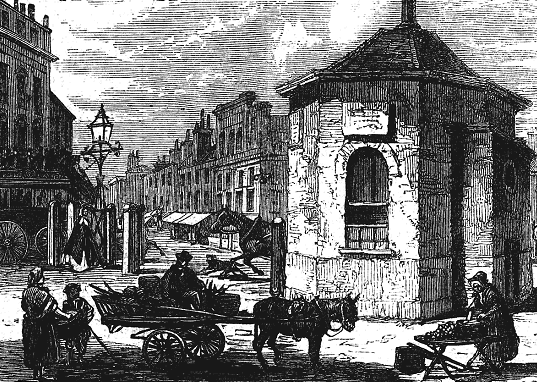
Islington toll house and toll gate.
From the Illustrated London News.
The improved roads had a great impact
on traffic, which soon increased through the town. It was a
good time for coaching inns because of the increased number
of coaches that now travelled via the town. Aris’s
Birmingham Gazette of 30th November, 1778 includes an
advert for the Shrewsbury, Wolverhampton, Walsall, and
Birmingham Fly. The fare from Walsall to Birmingham was
£1.7s.0d inside, or 13s.6d. (half fare) outside. In 1780 a
coach ran from Holyhead to London via Walsall and
Birmingham. The fare from Walsall to London was £1.11s.6d.
In 1784 Mr. Fletcher of the recently
built George Hotel, obtained an Act of Parliament for the
building of the road from Walsall to Stafford, and the
widening of the Birmingham Road as far as Hampstead Bridge.
In 1788 a turnpike Act provided for the repair and
improvement of the roads to Wolverhampton, Sutton Coldfield,
and Hampstead Bridge. It also allowed the reconstruction of
the Birmingham Road. Another turnpike Act, Passed in 1793
allowed the road from Churchbridge to Stafford to be
improved. This reduced the journey to the north by four
miles and greatly improved the town’s link with Chester,
Liverpool, and Manchester. It also encouraged traffic
heading north from Birmingham to pass through the town,
increasing the prosperity of the local inns and shops.
In 1831 Bradford Street was built to
provide a shorter and easier route to Darlaston and
Wednesbury.
Canals
The local canal network, the Birmingham
Canal Navigations (BCN) was built to transport coal from the
Black Country coalfields in the Wednesbury area into
Birmingham. James Brindley surveyed a possible route in 1767
and during the following year an Act of Parliament was
passed to allow the construction to go ahead. James Brindley
was appointed as engineer to the newly formed Birmingham
Canal Company, and work soon got underway. The section from
Birmingham to Wednesbury opened on 6th November,
1769. The canal reached Wolverhampton in August 1771, and
the final section to Aldersley Junction opened on 21st
September, 1772, just 8 days before Brindley's death. The
canal was a great success. Large quantities of coal,
limestone, sand, and Rowley ragstone were transported far
more cheaply and quickly than ever before, benefiting both
the canal company and the mining companies alike.

Rushall Locks. |
|
The Walsall Canal
In 1770 an attempt was made to form a
company to build a canal from Walsall to the Trent and
Mersey Canal near Lichfield. A meeting was held at the
Bull’s Head in Walsall to get the project underway, but it
never materialised.
The first canal to reach the outskirts
of Walsall town centre, the Wyrley & Essington Canal was
planned to link the coalfields of Wyrley and Essington to
the Birmingham Canal at Wolverhampton. An Act of Parliament
was passed on 30th April, 1792 to allow the work to
commence. Much of the finance came from Wolverhampton
businessmen, principally the Molineux family. Work soon
started under the canal company's engineer, William Pitt.
There were two branches, one to a colliery at Essington and
the other to Birchills. The canal joined the Birmingham
Canal at Horseley Fields in Wolverhampton, and opened on 8th May, 1797. In 1840 the canal was acquired by the BCN.
In 1794 another Act was passed to allow
the company to extend the canal to join the Birmingham &
Fazeley Canal. As a result the canal extended from Birchills,
through Bloxwich, Pelsall and Brownhills to the Birmingham &
Fazeley Canal. Being a contoured canal and following an
extremely circuitous route, it became known as "The Curly
Wyrley".
When the building of the new canal was
announced, the Birmingham Canal Company began to think about
building a canal from the end of the Broadwaters Extension
to Walsall via Darlaston. |
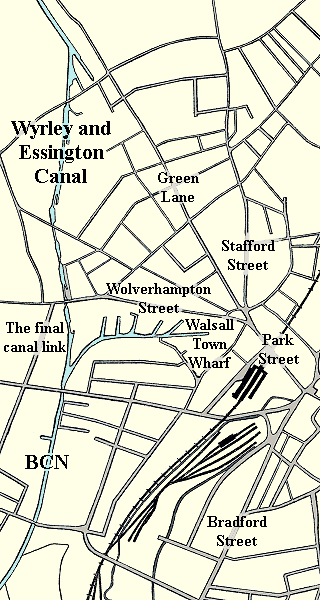 |
| On 17th April, 1794 an Act of Parliament was passed to
allow the work to begin, and in 1799 the Walsall Branch of
the Birmingham Canal Navigation opened from Walsall Town
Wharf, near Marsh Street and Navigation
Street, to Moxley, which was used as a base for
the many navvies that were involved in the work. The locals
far from welcomed them, except for the publicans and beer
sellers. One of the larger features is James Bridge aqueduct
which carries the canal over Bentley Mill Way and the River
Tame. This was completed in 1799 and is now a listed
building. The Walsall Branch, the first through route
between Walsall and the Birmingham main line was completed
in 1809. The final link in Walsall’s canal
network, which opened in 1841, joined the Birmingham Canal
to the Wyrley and Essington Canal. It allowed coal to be
brought from the Bloxwich and Pelsall coalfields into the
Walsall basin.
Some adverts from 1899:
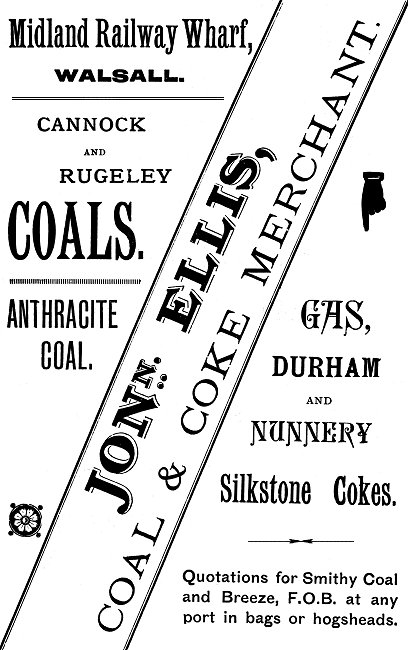
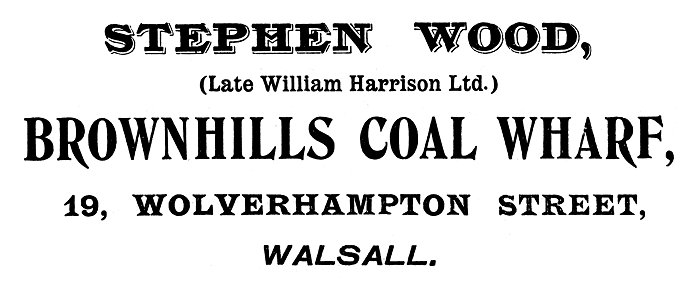
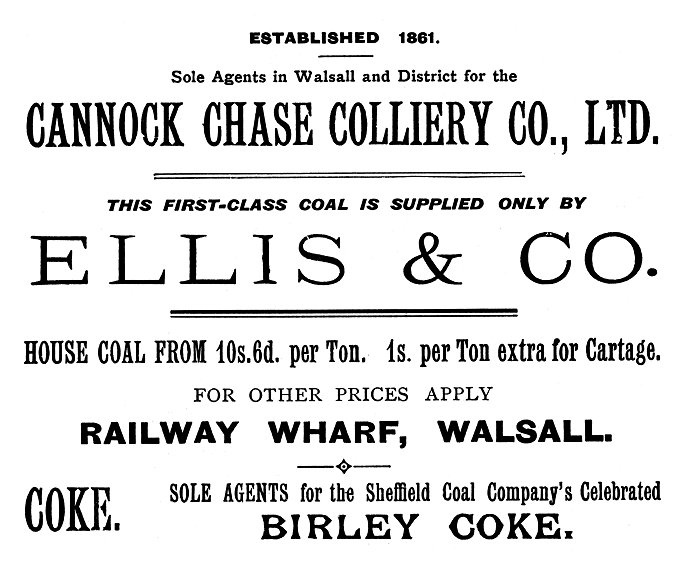
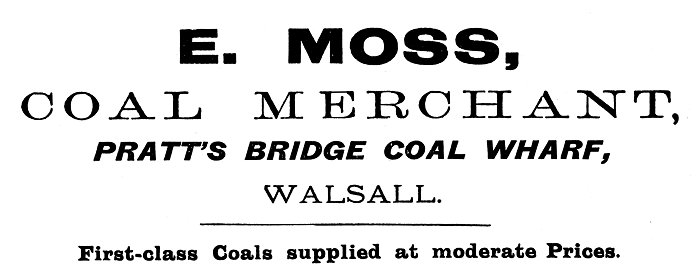
Railways
Following the success of the Liverpool
& Manchester Railway, which opened on September 15th 1830, many schemes were
proposed for the building of other railways. The earlier problems due to
lack of capital no longer applied and investors were easy to find. Other
towns and cities could see the benefits that would come from better links between
the nation's centres of commerce and industry. Birmingham businessmen were planning a
link to London, and the group of financiers that were involved with the
Liverpool & Manchester Railway could see that Birmingham would be an ideal
goal for expansion. In 1831 the Warrington & Newton Railway opened and
ran about 5 miles southwards from Newton Junction at the centre of the
Liverpool & Manchester Railway to Warrington, and the River Mersey. This
was considered to be an ideal starting point for a route to Birmingham, and
after much surveying, a route was found that was practical and avoided conflicts
with landowners.
The Bill for the Grand Junction
Railway, which was named after the Newton Le Willows junction, was passed in
Parliament on May 6th, 1833. This was the same day on which the Bill for the
London & Birmingham Railway was passed, and so work on the line quickly
proceeded.
Three engineers were employed to share
the engineering duties. They were George Stephenson, who was in overall
control, Joseph Locke, who looked after the construction of the northern
half, and John Rastrick who looked after the construction of the southern half.
Joseph Locke was determined to prove himself and laboured
vigorously in the construction of the line. Stephenson and
Rastrick were involved in other work, and not fully
committed to the project. Rastrick resigned in 1833, and
Stephenson resigned in 1835.
The last 14 miles were quite
troublesome and produced many unexpected problems. The first
was a small aqueduct carrying the Bentley Branch of the
Birmingham Canal across the Darlaston Green Cutting. A
temporary canal was built as a diversion while the aqueduct
was built. It used a cast iron liner to contain the water,
but when it was filled, a severe leakage developed. The
canal had to be re-diverted so that the problem could be
solved. This took a great deal of time and was the last part
of the construction work to be completed.
On the outskirts of Birmingham a detour
was needed around Aston Hall which required a further Act of
Parliament. This resulted in the hasty design and
construction of several extra bridges, viaducts and
embankments, which greatly increased Locke's workload. The
construction of the line in record time was a great
triumph for Locke. The average cost being less than the
estimated £20,000 per mile, which was very cheap when
compared with the £46,000 per mile for the London &
Birmingham Railway. |
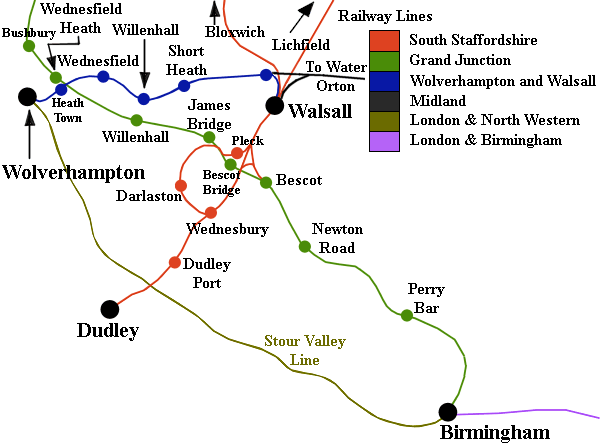
Walsall's early railways.
|

1st and 2nd class fares from Bescot Bridge.
|
Considering that this was the first
long-distance line in the world, its opening on
July 4th, 1837 was a
very quiet affair. A train pulling 3 coaches and a mail
coach set off from Liverpool, and a similar one set off from
Manchester. They met at Newton Junction where both trains
were combined and hauled southwards to Birmingham by the
locomotive ‘Wildfire’.
The local stations were as follows:
Wednesfield Heath (for Wolverhampton),
Willenhall, James Bridge (for Darlaston), Bescot Bridge (for
Walsall and Wednesbury), Newton Road (for West Bromwich),
Perry Bar, and Birmingham (Curzon Street)
Bescot Bridge, also known as Walsall
Station was the town’s first railway station. It stood on
the Wednesbury road near to the borough boundary.
A branch
to Walsall had been planned, but was not built. Passengers
travelled between the George Hotel and the station in a
small yellow one-horse omnibus in the charge of John Cox.
There were two trains daily, each way. Bescot Bridge Station closed in 1850,
and was reopened in 1881 as Wood Green Station. It finally
closed in 1941. |
|
Walsall’s first station in the town centre
The South Staffordshire Railway was
incorporated on 6th October, 1846 by an amalgamation
of two companies, the SS Junction, and the Trent Valley,
Midlands & Grand Junction. They had powers to construct
railway lines from the Oxford, Worcester & Wolverhampton
Railway at Dudley, to Walsall, and on to the Midland Railway
at Wichnor. There were to be spurs from Pleck to James
Bridge, to the Grand Junction Railway at Bescot, and the
Trent Valley line at Lichfield.
Work began at Walsall on the section to
Dudley. The first part from Walsall to the Grand Junction
Railway at Bescot (1¾ miles long) opened on 1st November, 1847, with a temporary station at Bridgeman Place,
off Bridgeman Street, opposite the junction with Station
Street. There were four trains each day running between
Walsall and Birmingham Curzon Street. Trains left Birmingham
at 9 a.m., 11 a.m., 4 p.m., 7.15 p.m., and left Walsall at
9.50 a.m., 11.30 a.m., 4.45 p.m., and 8.30 p.m. They were
worked by the newly formed London & North Western Railway,
founded on 16th July, 1846 by an Act of Parliament
which allowed the amalgamation of the Grand Junction
Railway, the London & Birmingham Railway, and the Liverpool
& Manchester Railway. Trains from the northern part of the
London & North Western Railway were still met at Bescot
Bridge by John Cox and his omnibus.
|
| A view of Walsall.
From Osborne's Guide to the Grand
Junction Railway, 1838. |
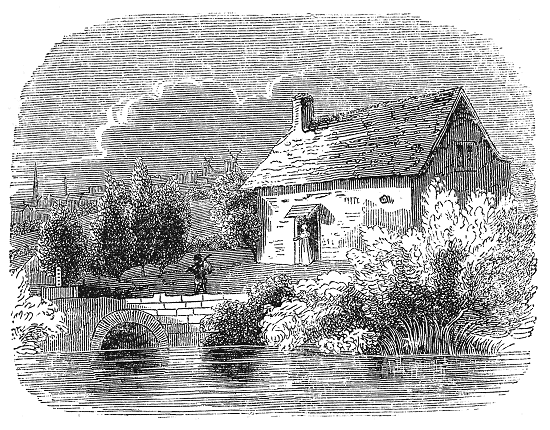 |
|
Building work on the new railway
continued towards Dudley, which had to be reached by 1st
November, 1849. The Act stated that if the company failed
to reach Dudley by that date, the Birmingham, Dudley &
Wolverhampton Railway would have running powers into Dudley.
The line was completed just in time, and a special train ran
from Pleck to Dudley on the day of the deadline. Because the
stations were far from complete, regular services didn’t
start until the following year. Goods services began in
March, passenger services on 1st May.
While this had been going on, work
progressed on the northern section from Walsall to
Lichfield, through Alrewas, and to Wichnor Junction, then on
the Midland Railway line to Burton-on-Trent. The new line
opened on 9th April, 1949. It was 17¼ miles long.
Work on the northern section also
involved the building of Walsall’s first permanent railway
station in Station Street, a Jacobean-style building
designed by Edward Adams of Westminster. When the new line
opened, a celebration dinner was held at Lichfield, along
with a ball at the Guildhall. The new station was
incorporated into the 1884 extension to Park Street. It
was burnt down during a severe fire in 1916, and later
rebuilt. It reopened in 1923, and survived until demolition
in 1978, when the existing station was built.
At this time the company began to use
its own locomotives and rolling stock. 29 locomotives were
purchased from several manufacturers, many of which were
named after local towns. They were as follows:
|
|
No. |
|
Name |
Manufacturer |
Details |
| 1. |
|
Dudley |
William Fairbairn & Sons, Manchester |
2-2-2 single |
| 2. |
|
Walsall |
William Fairbairn & Sons, Manchester |
2-2-2 single |
| 3. |
|
Wednesbury |
William Fairbairn & Sons, Manchester |
2-2-2 single |
| 4. |
|
Lichfield |
William Fairbairn & Sons, Manchester |
2-2-2 single |
| 5. |
|
Burton |
Sharp Brothers & Company, Manchester |
standard 5ft 6in. single |
| 6. |
|
Stafford |
Sharp Brothers & Company, Manchester |
standard 5ft 6in. single |
| 7. |
|
Bescot |
Sharp Brothers & Company, Manchester |
standard 5ft 6in. single |
| 8. |
|
Birmingham |
William Fairbairn & Sons, Manchester |
6-coupled, long boiler |
| 9. |
|
Wolverhampton |
William Fairbairn & Sons, Manchester |
6-coupled, long boiler |
| 10. |
|
Belvidere |
W. J. and J. Garforth, Manchester |
tender goods engine |
| 11. |
|
Angerstein |
W. J. and J. Garforth, Manchester |
tender goods engine |
| 12. |
|
Pelsall |
Robert Stephenson & Company, Newcastle |
6 coupled, long boiler |
| 13. |
|
Alrewas |
Robert Stephenson & Company, Newcastle |
6 coupled, long boiler |
| 14. |
|
Sylph |
Sharp Brothers & Company, Manchester |
standard 0-4-2 |
| 15. |
|
Safety |
Sharp Brothers & Company, Manchester |
standard 0-4-2 |
| 16. |
|
Viper |
E. B. Wilson & Company, Hunslet, Leeds |
0-6-0 goods engine |
| 17. |
|
Stag |
E. B. Wilson & Company, Hunslet, Leeds |
0-6-0 goods engine |
| 18. |
|
Esk |
E. B. Wilson & Company, Hunslet, Leeds |
2-4-0 goods engine |
| 19. |
|
Justin |
E. B. Wilson & Company, Hunslet, Leeds |
2-4-0 goods engine |
|
20. |
|
Priam |
Charles Tayleur & Company,
Vulcan Foundry,
Newton-le-Willows |
goods engine |
|
21. |
|
Ajax |
Charles Tayleur & Company,
Vulcan Foundry,
Newton-le-Willows |
goods engine |
| 22. |
|
Bilston |
Beyer, Peacock & Company, Gorton, Manchester |
front coupled tender engine |
| 23. |
|
Derby |
Beyer, Peacock & Company, Gorton, Manchester |
front coupled tender engine |
| 24. |
|
Cannock |
William Fairbairn & Sons, Manchester |
6-coupled, long boiler goods |
| 25. |
|
Bloxwich |
William Fairbairn & Sons, Manchester |
6-coupled, long boiler goods |
| 26. |
|
McConnell |
William Fairbairn & Sons, Manchester |
6-coupled, long boiler goods |
| 27. |
|
Vauxhall |
William Fairbairn & Sons, Manchester |
6-coupled, long boiler goods |
| 28. |
|
Aston |
William Fairbairn & Sons, Manchester |
6-coupled, long boiler goods |
| 29. |
|
Tipton |
William Fairbairn & Sons, Manchester |
6-coupled, long boiler goods |
| The carriage and wagon stock was
obtained from Joseph Wright and Sons,
Saltley, Birmingham. |
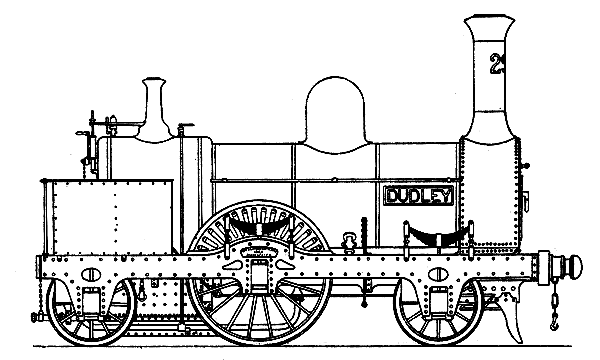 |
Number 1.
Dudley.
Carrying its later L&NWR number
297. |
| Number 16.
Viper.
Carrying its later L&NWR number
301. |
 |
 |
Number 19.
Justin.
Carrying its later L&NWR number
181. |
|
In 1850 an Act of Parliament was passed
to allow the South Staffordshire Railway board to lease the
railway to the company’s engineer John Robinson McClean for
21 years. The railway company realised that the amount of
traffic on the line would probably fall when the London &
North Western Railway’s Stour Valley Line opened. Under the
terms of the lease McClean had to pay a deposit of £10,000,
and guarantee a clear dividend of 2 percent in the first
year, and 4 percent afterwards, rising to 5 percent after 14
years.
The next development on the line took
place when McClean obtained mining concessions in the
Cannock coalfield and used the railway to transport his
coal. He built a new branch to Cannock with stations at
Bloxwich, Wyrley & Church Bridge, and Cannock.
In 1861 McClean relinquished his lease
to the London & North Western Railway, which immediately
entered into a battle with the Midland Railway over its
section from Wichnor Junction to Burton-on-Trent. The
Midland relented, giving full running powers to the London &
North Western, but would soon begin to play an important
role in Walsall’s rail network.
The
Wolverhampton & Walsall Railway
By the 1860s most of the local
manufacturing towns were easily and quickly accessible by
train from Wolverhampton. Two notable exceptions were
Willenhall and Walsall. Although they already had railway
stations, it was necessary to change trains during a
circuitous journey. An end to the tedium was in sight when
the Wolverhampton & Walsall Railway was incorporated on 29th June, 1865.
The route was 8 miles long and took 7
years to complete, with four intermediate Acts being passed
before the operation began. The line started at
Wolverhampton High Level station and ended at Walsall, with
five intermediate stations in between. They were at Heath
Town, Wednesfield, Willenhall, Short Heath, and
North Walsall in Bloxwich Road. The railway opened on 1st November, 1872 and was operated jointly by the London
& North Western Railway and the Midland Railway.
Disagreement arose between the two
companies and legal proceedings followed, which resulted in
the L.N.W.R. buying the Wolverhampton & Walsall Railway in
1875. The London & North Western realised that they would be
able to sell the line to the Midland Railway for a profit
because of the building of the Wolverhampton, Walsall &
Midland Junction line. This was an extension from the
Midland mainline onto the Wolverhampton & Walsall Railway,
and would provide a direct route into Wolverhampton for the
Midland Railway. The line was sold to the Midland Railway on
1st June, 1876. On 31st July, 1876 the L.N.W.R. ceased to
run services on the line.
|
|
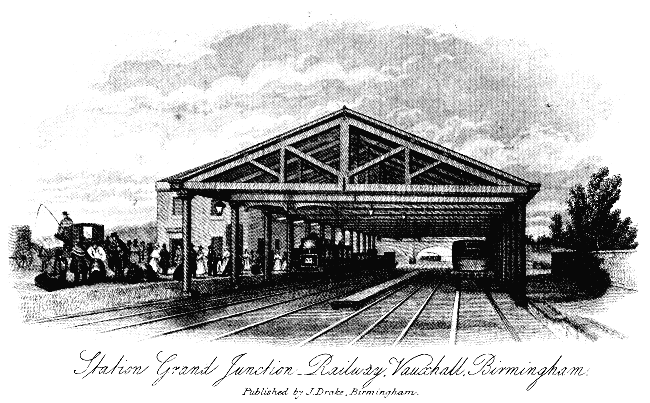
Birmingham's first railway
station. From Drake's Road Book of the Grand Junction
Railway, 1838. |
|
The Wolverhampton, Walsall & Midland
Junction line, and the Walsall & Water Orton line, which
joined the Midland mainline, opened on 1st July,
1879. The Midland Railway now had a direct route into
Walsall, and built its own goods yard on the site of the old
racecourse.
The Midland’s running powers into
Wolverhampton High Level station ended on 30th June
1878 and the company decided to build a railway station for
passengers in Wednesfield Road. An Act of Parliament
allowing construction was passed on 28th June, 1877,
but in the end the company built a goods depot instead.
By the time the local rail network had
been completed, Walsall had all of the necessary links in
place to ensure that its manufacturers could easily and
quickly acquire raw materials, and that the finished
products would be rapidly transported to destinations
throughout the country. The improved roads and the railway also had an impact on the town
centre, and the market. For the first time shoppers could
easily travel there, and so new shops appeared, and the town
became more prosperous. Thanks to the railway, locals began
to travel to more distant places for holidays and days out.
Excursion trains for both adults and children were well
supported. An early popular destination was Lichfield and
its cathedral. |

An advert from 1896.
 |
|
 |
|
 |
Return to The
18th Century |
|
Return to
the beginning |
|
Proceed
to Religion |
|